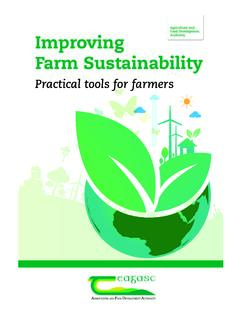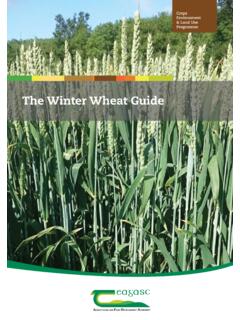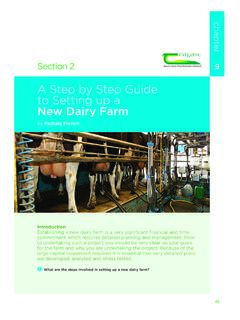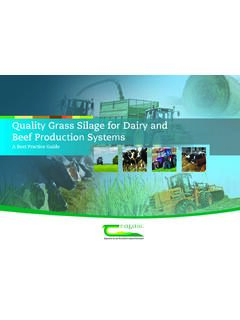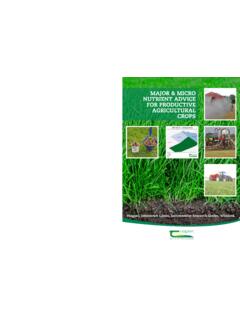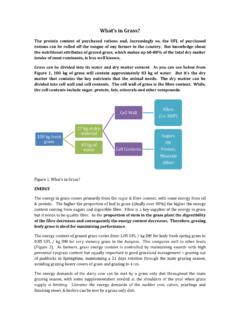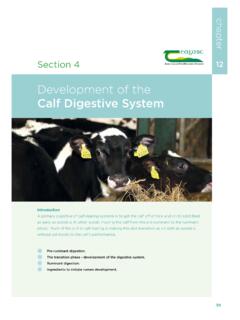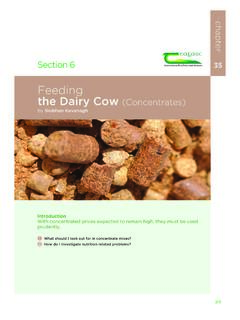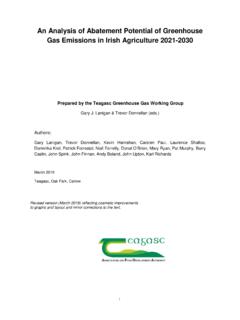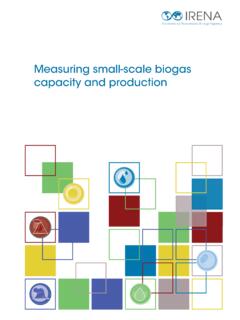Transcription of Key Environment Issues for Dairy Farmers
1 Chapter Section 4 23. 27. Key Environment Issues Issues for Dairy Farmers by Pat Murphy, Catherine Keena, Tim Hyde, Mark Gibson by Pat Murphy, Catherine Keena, Tim Hyde, Mark Gibson Introduction Environmental Issues Environmental Issues will will bebe an an increasing increasing challenge challenge for Dairy for Dairy Farmers butmay Farmers but mayalso also provide provide a marketing a marketing benefit benefit for Irish products for Irish on worldon products markets. world markets. 1 Why is greenhouse gas policy relevant relevant to to Dairy Dairy farming? farming? 2 What are the main greenhouse gases produced by farming? farming? 3 How can greenhouse gas emissions be reduced on Dairy farms?farms? 4 Why is water quality important for Dairy Farmers ? Farmers ? 5 How can countryside management benefit Dairy Farmers ? Farmers ? 163. 163. 1. KEY Environment issue 1 28/10/2011 16:03:36. chapter Key Environment Issues 27 for Dairy Farmers 1 Why is greenhouse gas policy relevant to 2 What are the main greenhouse gases Dairy farming?
2 Produced by farming? . Key Facts There are three main agricultural greenhouse gases: In Ireland agricultural greenhouse gases (GHGs) account Carbon dioxide CO2. for 33% of total GHGs. Methane CH4. The average for the EU 27 is 9%. Nitrous oxide N2O. Agricultural GHGs have fallen by almost 10% since 1990. Methane Methane is the most important GHG in Irish agriculture. Achieving Food Harvest 2020 targets is projected to lead to It is 25 times more potent than CO2 (1kg CH4 = 25kg CO2. an increase of 7% in GHG emissions compared with 2010. equiv.). The main sources are fermentation in the ruminant levels. animal and manure storage and handling.. The commitments Nitrous oxide Nitrous oxide is 296 times more potent than CO2. The main The European Union has committed itself to a sources are the application of artificial and organic manures reduction of 20% below 1990 levels' by 2020 with and animal excreta (mainly urine) deposited on grassland.
3 An agreement to increase this to 30% as part of a global agreement. Carbon dioxide The EU is committed to a 40% cut in emissions Carbon dioxide from Irish agriculture arises mainly from the by 2030. use of energy on the farm and in the transport of farm inputs and produce. While CO2 accounts for only a small proportion of agricultural greenhouse gasses, there is scope to reduce this on many farms. From the market There is increasing pressure from manufacturers Policy and retailers to reduce GHG emissions in the Counting greenhouse gas emissions inputs/products being purchased. This will result in pressure on Farmers to quantify GHG emissions of There is considerable argument about how best to account their output and to put measures in place to reduce it. for the greenhouse gas emissions from the agricultural sector. This issue is important because future policies on controlling GHGs will be based on a system of counting carbon.
4 IPCC (International Panel on Climate Change) vs LCA (Life Cycle Analysis). Both methodologies calculate the carbon footprint for agricultural output produced in the country. The main difference between the two methodologies is that IPCC. measures the carbon which was actually produced in the country while the LCA methodology calculates the carbon emissions associated with the food regardless of where it occured. This includes the carbon footprint of imported inputs such as fertiliser and meals. 164. chapter 23. 27. Food produced in Ireland is very efficient when considered in Slurry spreading and storage. Timing and spreading terms of kg of CO2 per kg of product. In a report produced technology have a significant impact on GHG emissions. by the Joint Research Committee (JRC) of the EU, Irish Dairy Reducing N losses to water and air are important from an production was ranked first and beef production fifth in environmental perspective but also lead to increased the EU 27, in terms of kg CO2 per kg of output.
5 On the world availability for plant growth. stage, Ireland is amongst the most carbon efficient producers of milk and beef. Correct nitrogen usage. Getting the timing and type of nitrogen fertiliser type right for the prevailing conditions can significantly reduce losses and improve the effectiveness of The dilemma: carbon leakage N fertiliser Ireland has committed to challenging targets to reduce carbon emissions. Developing countries do not Improved liveweight gain improves GHG efficiency by have the same targets. reducing finishing age and/or increasing carcass weight and thereby reducing the emissions per unit of output. If Ireland reduces agricultural output to meet GHG. targets, the production of food may shift to less carbon Land Use sequestration. Grassland and forestry take efficient countries. carbon dioxide out of the atmosphere and store it in wood and soil. This will lead to a global increase in global GHG. emissions.
6 Fortunately, most of the mitigation options outlined above are consistent with improving the efficiency and profitability of the It is important to bear in mind that demand for food Dairy farm. Adopting these technologies could significantly is growing in line with world population. reduce the carbon footprint of Irish dairying. 4 Why is water quality important for 3 How can greenhouse gas emissions be Dairy Farmers ? reduced on Dairy farms? When compared with other EU member States, Ireland has To improve sustainability and to meet legislative and market good water quality. The 2010-2012 water quality report, requirements, it is important for all Dairy Farmers to reduce published by the EPA, shows evidence of improvements in their carbon footprint. water quality in Ireland. However, there is a considerable challenge to meet the target of good status for all water There are opportunities to reduce CH4 emissions through bodies (currently ).
7 Increased efficiency and adoption of a range of management practices: The main pressures on Irish water quality arising from agriculture include: phosphorus, nitrate, sediment and Increased grazing season increases grass utilisation and pathogens. These pressures are controlled under the reduces the volume of slurry to be stored and spread. A 10 Nitrates Regulations. day increase in the grazing season can reduce GHG per kg beef by approximately 2% Importance of high quality water Better production and utilisation of grass means improved At an industry level, Ireland's high water quality contributes to nitrogen efficiency and improved animal performance. our green' image and is crucial to the future marketing Inclusion of clover in swards can significantly reduce GHG of Irish Dairy products. emissions by replacing purchased N with clover fixed N. Good quality surface and groundwater is needed for human Efficiency per cow. Your cow produces the same level of and animal health, fisheries, tourism, and wildlife and habitat CO2 equivalents per year as an efficient car travelling 17,000 conservation.
8 Km per annum. Unproductive cows increase your carbon footprint. You can reduce this by improving calving rates through improved fertility management, lowering the age at first calving. 165. chapter Key Environment Issues 27. 1 for Dairy Farmers Legislation Approximately 80% of the world's population live in areas The 2003 Water Framework Directive was established to where the fresh water supply is not secure. International coordinate existing water legislation. The Water Framework research has shown that grass-based Dairy systems, such Directive requires river basin management districts (RBDs) as we have in Ireland, have the lowest water footprint. This to be established in each member state. Eight RBDs have places Ireland in a strong position to continue to produce milk been established, each of which must develop and implement competitively with both a low water and carbon footprint. a management plan. The plans contain detailed standards for measurements of water such as biological and chemical 5 How can countryside management benefit status which must be reached within a specific timescale.
9 Dairy Farmers ? The Nitrates Regulations were introduced in Ireland in Biodiversity enhances farms and the rural countryside. 2006 and updated in 2010, and 2014. The regulations are It contributes to the green' image of dairying. Leaving space designed to control diffuse and point source pollution from for biodiversity maintains assets for future generations. agriculture. Dairy farms can help to halt the decline in Ireland's It is vital that Dairy Farmers play their part in protecting water biodiversity and contribute to a living landscape in their quality by ensuring that they put in place an effective own rural area. Examples of biodiversity enhancement nutrient management plan, ensure that there is no point on Dairy farms are: source losses to the Environment and comply with the planting native Irish trees in corners or rows provisions of the Nitrates Regulation. erecting bird or bat boxes Key Actions creating a pond Nutrient Management growing a small area of a crop for wildlife Carry out soil nutrient analysis on all fields on the farm planting new stock-proof hedgerows and maintaining/ Prepare a nutrient management plan consistent with improving existing hedgerows.
10 Nutrient status and level of output The decline in biodiversity can be halted by a network Apply lime as per recommendation of biodiversity areas on all farms in the country. Agri- Environment schemes provide opportunities Utilize slurry effectively to invest in the future of your farm. Apply the correct level of appropriate chemical fertiliser at the right time Hedgerows Common images which market Irish farm produce inevitably Point source management feature cattle in lush green fields with scenic hedgerows in Ensure clean water is separated the background. Hedgerows are now landscape features which means the area beneath them is eligible for the single Make sure there is adequate slurry storage payment scheme. In order to avoid penalties under cross compliance, Farmers must replant an equivalent length Pay particular attention to farm roadways, yards and silage elsewhere before removal of any hedgerows. Hedgerows pits to ensure that there is effective collection of soiled must not be trimmed from March to August to avoid the water and no potential for losses to watercourses destruction of nesting birds.
